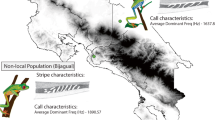Abstract
Evolution of the mate recognition system (MRS) can play a central role in animal speciation. One dramatic consequence of changes in the MRS is the failure of individuals from divergent lineages to successfully court and mate, thereby reducing gene flow between these groups. Here, we test the role of an acoustic mating signal on mate choice in a Hawaiian cricket genus (Gryllidae: Laupala). Speciation in Laupala is proceeding at an extremely rapid rate, apparently driven by divergence in aspects of the mate recognition system, most conspicuously the pulse rate of male calling song. Previous studies demonstrate that females prefer the pulse rate of a conspecific male’s song when perceived at long range, in laboratory phonotaxis trials. In this study, we examined mate choice in two species that differ dramatically in pulse rate: Laupala paranigra and Laupala kohalensis. We tested the female’s preference in both species for pulse rates at close range, by providing females an opportunity to mate with hybrid males producing a range of intermediate pulse rates. Results of our study demonstrate that while strong behavioral barriers exist between these two species, variation in the pulse rate of male calling song did not predict female mate choice at close range. These results suggest a more complex architecture to mate recognition in Laupala than previously hypothesized.



Similar content being viewed by others
References
Andersson M (1994) Sexual selection. Princeton University Press, Princeton, NJ
Butlin RK, Ritchie MG (1994) Behaviour and speciation. In: Slater PJB, Halliday TR (eds) Behaviour and evolution. Cambridge University Press, Cambridge, pp 43–78
Candolin U (2003) The use of multiple cues in mate choice. Biol Rev 78:575–595
Clague DA, Dalrymple GB (1987) The Hawaiian-Emperor volcanic chain. In: Decker RW, Wright TL, Stauffer PH (eds) Volcanism in Hawaii. US Government Printing Office, pp 5–54
Coyne JA, Crittenden AP, Mah K (1994) Genetics of a pheromonal difference contributing to reproductive isolation in Drosophila. Science 265:1461–1464
Gerhardt HC, Huber F (2002) Acoustic communication in insects and anurans: common problems and diverse solutions. University of Chicago Press, Chicago
Ginzel MD, Blomquist GJ, Millar JG, Hanks LM (2003) Role of contact pheromones in mate recognition in Xylotrechus colonus. J Chem Ecol 29:533–545
Gray DA (2004) Does courtship behavior contribute to species-level reproductive isolation in field crickets? Behav Ecol 16:201–206
Howard DJ (1993) Reinforcement: origin, dynamics, and fate of an evolutionary hypothesis. In: Harrison, RG (ed) Hybrid zones and the evolutionary process. Oxford University Press, New York, pp 46–69
Howard RW, Jackson LL, Banse H, Blows MW (2003) Cuticular hydrocarbons of Drosophila birchii and D. serrata: identification and role in mate choice in D. serrata. J Chem Ecol 29: 961–976
Johnstone RA (1996) Multiple displays in animal communication: ‘backup signals’ and ‘multiple messages.’ Philos Trans R Soc Lond B 351:329–338
Mendelson TC, Shaw KL (2002) Genetic and behavioral components of the cryptic species boundary between Laupala cerasina and L. kohalensis (Orthoptera: Gryllidae). Genetica 116:301–310
Mendelson TC, Siegel AM, Shaw KL (2004) Testing geographic pathways of speciation in a recent island radiation. Mol Ecol 13:3787–3796
Mendelson TC, Shaw KL (2005) Sexual behaviour: rapid speciation in an arthropod. Nature 433:375–376
Otte D (1994) The crickets of Hawaii: origin, systematics, and evolution. Orthoptera Society/Academy of Natural Sciences of Philadelphia, Philadelphia
Parsons YM, Shaw KL (2001) Species boundaries and genetic diversity among Hawaiian crickets of the genus Laupala identified using amplified fragment length polymorphism. Mol Ecol 10:1765–1772
Paterson HEH (1985) The recognition concept of species. In: Vrba, ES (ed) Species and speciation. Transvaal Museum monograph No. 4, Pretoria, pp 21–29
Patricelli GL, Uy JAC, Borgia G (2003) Multiple male traits interact: attractive bower decorations facilitate attractive behavioural displays in satin bowerbirds. Proc R Soc Lond B 270:2389–2395
Shaw KL (1996) Sequential radiations and patterns of speciation in the Hawaiian cricket genus Laupala inferred from DNA sequences. Evolution 50:256–266
Shaw KL (2000a) Further acoustic diversity in Hawaiian forests: two new species of Hawaiian cricket (Orthoptera: Gryllidae: Laupala). Zool J Linn Soc 129:73–91
Shaw KL (2000b) Interspecific genetics of mate recognition: inheritance of female acoustic preference in Hawaiian crickets. Evolution 54:1303–1312
Shaw KL (2002) Conflict between mitochondrial and nuclear DNA phylogenies of a recent species radiation: what mtDNA reveals and conceals about modes of speciation in Hawaiian crickets. Proc Natl Acad Sci USA 99:16122–16127
Shaw, KL, Herlihy, D (2000) Acoustic preference functions and song variability in the Hawaiian cricket Laupala cerasina. Proc R Soc Lond B 267:577–584
Shaw KL, Parsons YM (2002) Divergence of mate recognition and its consequences for genetic architectures of speciation. Am Nat 159:S61–S75
Shaw KL, Khine AH (2004) Courtship behavior in the Hawaiian cricket Laupala cerasina: males provide spermless spermatophores as nuptial gifts. Ethology 110:81–95
Takahashi A, Ting C-T (2004) Genetic basis of sexual isolation in Drosophila melanogaster. Genetica 120:273–284
Tregenza T, Wedell N (1997) Definitive evidence for cuticular pheromones in a cricket. Anim Behav 54:979–984
Acknowledgements
We thank T. deCarvalho for assisting in behavioral observations, and two anonymous reviewers for helpful comments on the manuscript. The research was funded in part by NSF training grant DBI-9602266 to T.C.M. and NSF grant DEB-9729325 to K.L.S.
Author information
Authors and Affiliations
Corresponding author
Additional information
Communicated by D.T. Gwynne
Rights and permissions
About this article
Cite this article
Mendelson, T.C., Shaw, K.L. Close-range acoustic signaling and mate choice in Hawaiian crickets (Gryllidae: Laupala). Behav Ecol Sociobiol 59, 770–776 (2006). https://doi.org/10.1007/s00265-005-0107-7
Received:
Revised:
Accepted:
Published:
Issue Date:
DOI: https://doi.org/10.1007/s00265-005-0107-7




